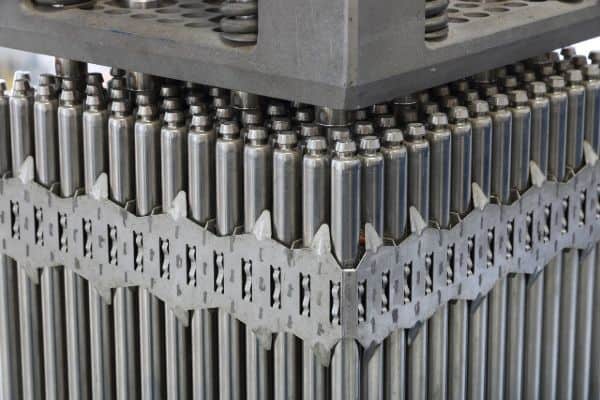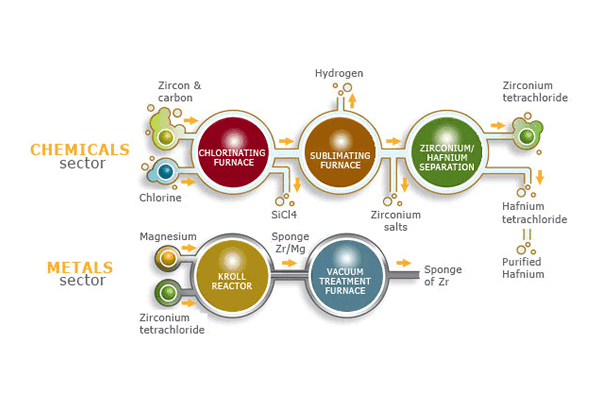Zirconium sponges are produced by injecting gas or mixing a foaming agent into molten metal, creating a froth that is stabilized by a high-temperature foaming agent.
Zirconium sponges are cellular structures made with a large volume fraction of pores. Sponge traits include low density, high stiffness, high energy absorbance, low thermal conductivity, low magnetic permeability, fire resistance, and sound dampening qualities. Zirconium sponges are used in a wide variety of applications including heat exchangers, for energy absorption, flow diffusion, and lightweight optics.

The main use for zirconium sponge is in the nuclear industry where a minimum content of hafnium is needed. It features in nuclear and non-nuclear grades (of which about 70% is nuclear grade) and is used to produce zirconium alloys for nuclear reactor components, such as cladding for fuel rods.
The chemical and physical similarity of zirconium and hafnium means that the separation of these two metals is difficult.
The traditional process involves the direct chlorination of zircon flour in a fluidised bed containing carbon, the chemical reaction being:
ZrSiO4 + 4C + 4Cl2 → ZrCl4 + SiCl4 + 4CO
The chlorination process produces tetra-chlorides of zirconium, hafnium and silicon from which the silicon is removed by sublimation, enabling the separation of the zirconium and hafnium tetra-chlorides by solvent extraction or distillation.
Zirconium tetra-chloride is then reduced to the metallic form with magnesium using the Kroll process:
ZrCl4 + Mg → Zr + 2MgCl2
The metallic zircon sponge is then crushed and milled to the required size.
A typical composition of nuclear-grade zirconium alloys is more than 95% by weight zirconium and less than 2% of tin, niobium, iron, chromium, nickel and other metals, which are added to improve mechanical properties and corrosion resistance.
Non-nuclear or industrial grade - with a minimum of 0.2% hafnium - is used to produce zirconium alloys for applications such as chemical processing. ASTM allows 0.4-0.5% hafnium in zirconium alloys.
Zirconium metal is protected by a thin oxide layer, making it exceptionally resistant to corrosion by acids, alkalis and seawater. For this reason, it is extensively used by the chemical industry.
Zirconium (IV) oxide is used in ultra-strong ceramics and even scissors and knives can be made from it. It is used to make crucibles that will withstand heat-shock, furnace linings, foundry bricks, abrasives and by the glass and ceramics industries. Zirconium oxide is also used in cosmetics, antiperspirants, food packaging and to make microwave filters.

Zircon, also referred to as zirconium silicate (ZrSiO4), is a co-product from the harvesting and processing of ancient heavy mineral sand deposits. Found mainly in Australia and South Africa, zircon can be used either in its coarse sand form or milled to a fine powder. Its properties ensure that it is used in many everyday products, including ceramic tiles and medical implants, as well as having major industrial applications.
Zircon can be processed to create zirconia by melting the sand at very high temperatures to form molten zirconia, also known as zirconium oxide (ZrO2).
Zirconium, another derivative of zircon, is the chemical element Zr in the Periodic Table and takes the form of a silvery grey metal. As the 18th most abundant element in the earth’s crust, it commonly occurs in the mineral zircon in silicate form and, less frequently, in the mineral baddeleyite in oxide form.
Zircon has a theoretical content of 67% zirconia and 32% silica and it can typically contain a small percentage of hafnium in the range of 0.2 to 4%.
Zircon sand (zirconium silicate) is mined from mineral sand deposits.
Used mainly in the ceramics industry, zircon flour is manufactured by milling zircon sand.
Find out how zircon, used as an opacifier, provides high whiteness and brightness in ceramics.
There is a wide range of zirconium-based chemicals.
Zirconia, found naturally in baddeleyite, is also chemically derived from zirconium.
Zirconium, a silvery grey metal, is the chemical element Zr in the Periodic Table.
Zirconium sponge is used mainly in the nuclear industry.
A summary of the unique physical properties of zircon.